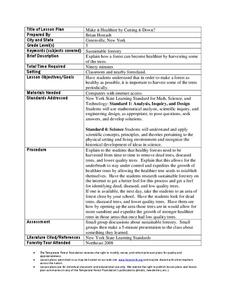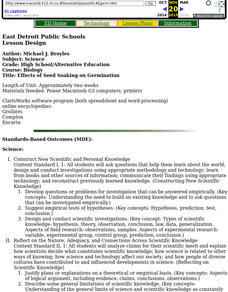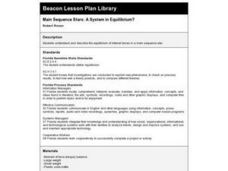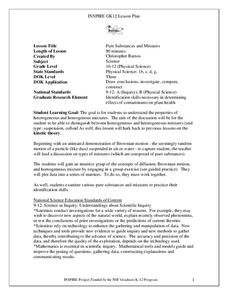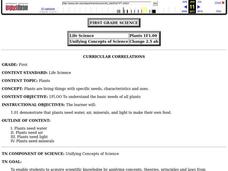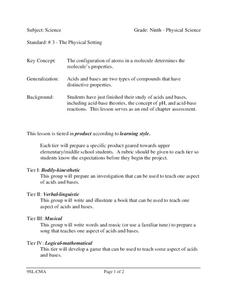Curated OER
Make it Healthier by Cutting it Down?
Fifth graders discuss sustainable forestry. In this forestry lesson, 5th graders discuss how healthy forests need to have dead, diseased and lower quality trees cut down and harvested. They visit a local forest and identify these 3 types...
Curated OER
The Memory Play in American Drama
High schoolers take a closer look at a memory play. In this American drama lesson, students read Tennessee Williams's The Glass Menagerie and analyze it as a memory play. High schoolers discuss the linear and non-linear aspects of the...
Curated OER
Scientific Method
Students complete a basic science experiment as a class and go through the steps of the scientific method. In this scientific method lesson plan, students do this all together as an introduction.
Curated OER
Cell Structure and Function
Students compare the organelles present in plant and animal cells. For this biology lesson, students create an analogy to easily remember their assigned organelles. They also research their function and write a creative story.
Curated OER
The Genetic Basis of Neurological Disorders
Students describe some aspects of known genetic defects on the human neurological condition. They participate in a variety of exercises including drawings, games, and analogies.
Curated OER
Keynesian Economics and Fiscal Policy
Students examine and analyze the characteristic problem of each phase of the business cycle. Students articulate the appropriate choices for each of the problems described. Students apply the writing process to write an essay.
Curated OER
Micro-Magic With Sticky Ions
Pupils view a video about the formation of precipitates. They complete a worksheet that asks them to identify what makes a compound form and what holds it together.
Curated OER
Effects of Seed Soaking on Germination
High schoolers explain the standard growth pattern of a monocot seedling and word process a finished essay.
Curated OER
Yeast Cells and Their Environment
Students create their own experiment in which they have yeast cells growing in liquid environments. They examine the relationship between humans and microorganisms. They also practice using the scientific method.
Curated OER
Studying Living Organisms
Students discover and discuss the differences between prokaryotes and eukaryotes. Using a microscope, they examine various prepared slides of prokaryotic and eukaryotic organisms.
Curated OER
Animals
Second graders discuss the term "endangered". They identify the reasons some animals are in danger of being wiped out. They discover ways humans can help the species survive.
Curated OER
Simple Machines
Fifth graders study how simple machines can help us alter forces and discuss the term mechanical advantage. They then identify dysfunctional simple machines and discuss in groups how the dysfunctions will decrease the effectiveness of each.
Curated OER
Teaching about Islam
Ninth graders explore the effects of globalization on the Global South. In this World History instructional activity, 9th graders research a specific Islamic region. Students create a presentation that explain the effects of...
Curated OER
Inflation and Money
Learners define money in terms of its functions and refer back to discussion of markets and the role of money in reducing transaction costs. They give examples of types of money.
Curated OER
Main Sequence Stars: A System in Equilibrium?
Fourth graders study the equilibrium of internal forces in a main sequence star.
Curated OER
The Acid Rain Test
Fourth graders engage in a research project to increase their ability to conduct experiments, interpret data and discuss results in a scientific paper. After doing a lab which simulates effects of acid rain, pairs of students write a...
Curated OER
Scientific Inquiry: Periodic Motion
Learners construct their own pendulum. In this physics lesson plan, students design an experiment to find the factors affecting its period. They formulate a conclusion based on experimental data.
Curated OER
Pure Substances and Mixtures
Students compare and contrast the properties of substances and mixtures. In this chemistry lesson, students simulate spontaneous mixing by performing a short class activity. They differentiate heterogeneous and homogeneous mixtures.
Curated OER
Oceanography
Fifth graders study the topography of the ocean floor. They determine its ever changing nature as they examine currents and trade winds. They write paragraph describing how the winds might affect land formations after the discussion of...
Curated OER
Why do we need Vitamin C in our diet? Or Why do we carry old inactive genes in our genome?
Students explore and explain how mutations in the DNA sequence of a gene may be silent or result in phenotypic change in an organism and in its offspring. They analyze how evolution and biodiversity are the result of genetic changes that...
Curated OER
Plants
First graders explore the specific needs, characteristics, and uses of plants. They discuss the needs of plants as they grow. Students observe plants in various settings as they grow and note the changes they see.
Curated OER
The Effects of Temperature on Solids
Young scholars explore the effects that extreme temperatures have on the material properties of solids. They investigate the properties of a material whose state depends on extreme temperatures and witness how it interacts with room...
Curated OER
The Physical Setting
Ninth graders study the configuration of atoms in molecules to see that it determines the molecule's properties. In this chemistry lesson students divide into groups and complete their assigned task.
Curated OER
From Molecules to Mole Day Do's
Students recognize methods used to define the mole. After converting various quantities to the mole, students provide a context for understanding the usefulness of scientific notation and the mole.


